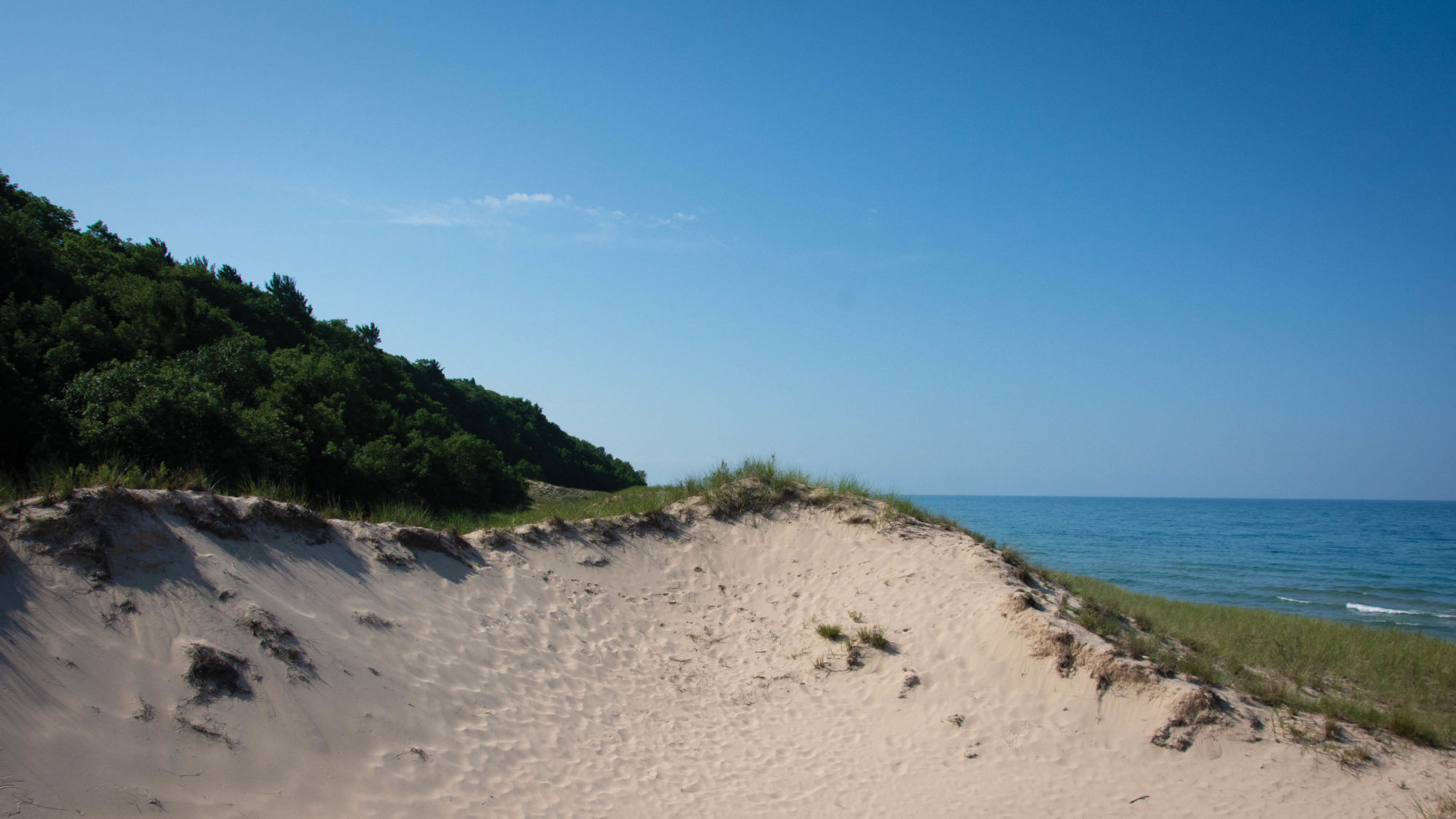
What we protect when we protect the dunes
LCWM Board Member and dune geoecologist Suzanne DeVries-Zimmerman shares her thoughts on one of West Michigan’s most iconic landscapes.
Lake Michigan’s scenic sand dunes were a part of Suzanne DeVries-Zimmerman’s life well before she was born. Her parents met at a beach party, and when Suzanne’s mother was pregnant with her, she and her husband would hike along Goshorn Lake and Oval Beach in Saugatuck, Michigan.
For Suzanne, who grew up in Holland, Michigan, the dunes were always nearby—at least they were until she moved out east to pursue her master’s degree in geological and geophysical sciences at Princeton University.
“Going to the beach and hiking through the dunes was one of those activities that frankly, until we moved out to New Jersey, I took for granted,” Suzanne said.

Suzanne DeVries-Zimmerman (left) and team collect sediment cores to see what triggered times of dune mobility and dune stability in the past.
Living in a place where beaches were much more difficult to access and the sand dunes were not well preserved made Suzanne appreciate just what she had growing up in Holland. When she moved back to teach at her alma mater, Hope College, a colleague invited her to contribute to research about the sand dunes, and she accepted.
“I thought, this would be a great opportunity to do research in an area that I absolutely love,” she said, and the die was cast.
Now, Suzanne is part of an interdisciplinary team of scientists who study West Michigan’s dunes: the Hope College Dune Research Group. Informed by her background in biology and geology, her research focuses on coastal dune dynamics and the ecological systems of the dunes. Part of her research takes place at a property the Land Conservancy helped protect—Saugatuck Harbor Natural Area. She and her team are conducting a long-term study of the natural area’s interdunal wetlands to help understand the factors influencing the wetlands and the ecological communities there.
“It’s a rare privilege to be able to work in an environment that you have just loved for years,” Suzanne said.
As a board member of the Land Conservancy, Suzanne has participated in efforts to protect similar spaces, including Flower Creek Dunes Nature Preserve. She appreciates the preserve for the diversity of its foredune and parabolic dune aspects.
“The part that I love about that foredune area is all the different little microclimates and all the different open dune species that are in there,” she said.
It’s all about sand movement
One reason you see so many different species of plants in Flower Creek Dunes Nature Preserve is because the sand shifts to varying degrees throughout the system, and each plant prefers a specific range of sand movement.
“Beach grass, or marram grass, likes a lot (of sand movement), and it will tolerate a lot of sand burial. That’s why you see it pretty much exclusively on the dunes closest to the lake,” Suzanne said. “Then as that sand deposition tapers off . . . that’s when we start to see the later successional species in the open dunes: Pitcher’s thistle, which we all love, Gillman’s goldenrod, beach pea, bugseed, hoary puccoon—all of those fabulous plants love an environment where there’s a little bit of sand movement, but definitely not a meter or even more than that.”
Preserving those microclimates, and the diverse plants and creatures they support, goes beyond protecting just the foredune area. This habitat is part of a spectrum of related habitats as a result of what ecologists call “succession”—the change in the species structure of an ecological community over time. Each part of the spectrum depends upon the others for its continued resilience.
“At Flower Creek, you have that variety within the open dunes, and that is not only an essential characteristic, but in order to retain the integrity of that system you need to have multiple stages of succession,” Suzanne said. “Some (parts of the dunes) are completely forested, some partially, and some are getting more sand deposition—you need all of that variety,”
The amount of sand movement decreases as you move away from the lakeshore, to the point where the parabolic dunes become completely forested, and roots of the trees slow the sand movement to negligible amounts. This is the case on the eastern edge and beyond the bounds of Flower Creek Dunes Nature Preserve. These hilly forests contain their own important microclimates and a wealth of plant and wildlife species.
“The last thing we want to do is choke that all off and stabilize them so they’re not moving anymore, because that destroys the whole ecosystem,” Suzanne said. “We want multiple succession pathways. We want to maintain that open dune environment—so some parts will be allowed to go all the way through the successional path and end up as a forested, stable dune.”
Luckily, thanks to the Paprocki family, 43 acres of the forested dunes adjacent to Flower Creek Dunes Nature Preserve have been protected by a conservation easement and thoughtfully stewarded for over two decades. The Land Conservancy has the opportunity to acquire this land to add to the preserve and manage it as a whole, ensuring the whole spectrum of habitats is protected in perpetuity.
More than just their ecological value
For Suzanne, protecting these landscapes is not only important for their ecological value, but for their healing power. She recounted a particularly challenging time when both her mother and husband faced serious accidental injuries:
“The thing that kept me going was being able to go out to the beach for water levels and feeling that release, of being out in nature and realizing that, ‘Okay, all is not lost,’” Suzanne said. “Being able to make that connection enabled me to hold it together through a very difficult time in my life.”
Now, Suzanne faces another difficult time. Her mother, 95, is in hospice care with a failing heart. Suzanne has been reflecting on her mother’s life. She recalled a time when her mom accompanied her on a trip to gather data at Saugatuck Harbor Natural Area and shared a hypothesis of her own: that those trips to the beach while she was pregnant with Suzanne had some influence on Suzanne’s chosen career path.
“Mom’s convinced that somehow that exposure to the dunes created a predisposition to going back there in my later years and studying them, and who am I to argue. It’s as good a reason as any,” she said.
Together, we can ensure that future generations can grow up exploring these dunes and making them as much a part of their lives as they were for Suzanne and her family. Right now, you can help by donating to the Land Conservancy’s campaign to acquire 43 acres of forested dune habitat adjacent to Flower Creek Dunes Nature Preserve. Learn more here.








Cindy A
Wonderful, Suzanne! So fun to read your story.
Thank you for all you do!